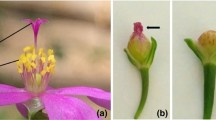Abstract
Pollination biology of the saprophytic speciesPetrosavia sakuraii was investigated in Central Japan. The flower opens at any time of the day, and the anthers of outer stamens dehisce after about one day and those of the inner stamens after two days. The stigmata on the semicarpous (nearly apocarpous) pistil, which are already receptive when the flower opens, are situated in the center of the flower and move gradually outwards to touch the anthers of outer stamens about five days after anthesis. The breeding experiments show that the stigmata are receptive at least for five days, and many seeds are produced through autonomous self-pollination. That means the nearly apocarpous pistil, which is in a primitive condition, is adapted to the autonomous self-pollination. The selfing rate including insect-mediated self-pollination is very high, and this sexual-reproductive system seems favorable to the saprophytic plant which is probably severely limited in its resources. However, cross-pollination also may be performed by the small bees of Lasioglossum and some other insects, even though they do not so frequently visit the flowers and the out-crossing rate is low.
Similar content being viewed by others
References
Akazawa, T. andTamura, M. 1924.Protolirion sakuraii occurring in Kyoto. Acta Phytotax. Geobot.15: 138 (in Japanese).
Beaman, R.S., Dicker, P.J. andBeaman J.H. 1988. Pollination ofRafflesia (Rafflesiaceae). Amer. J. Bot.75: 1148–1162.
Beattie, A.J., Turnbull, C., Knox, R.B. andWilliams, E.G. 1984. Ant inhibition of pollen function: a possible reason why ant pollination is rare. Amer. J. Bot.71: 421–426.
Beattie, A., Turnbull, C., Hough, T., Jobson, S. andKnox, R.B. 1985. The vulnerability of pollen and fungal spores to ant secretions: evidence and some evolutionary implications. Amer. J. Bot.72: 606–614.
Bernhardt, P. andThien, L.B. 1987. Self-isolation and insect pollination in the primitive angiosperms: new evaluations of older hypotheses. Pl. Syst. Evol.156: 159–176.
Charnov, E.L. 1987. On sex allocation and selfing in higher plants. Evol. Ecol.1: 30–36.
Chen, S. 1980.Petrosavia.In Flora Reipublicae Popularis Sinicae, vol. 14, pp. 12–13. Science Press, Peking (in Chinese).
Cronquist, A. 1981. An Integrated System of Classification of Flowering Plants. Columbia University Press, New York.
Cruden, R.W. 1977. Pollen-ovule ratios: a conservative indicator of breeding systems in flowering plants. Evolution31: 32–46.
Cruden, R.W. andLyon, D.L. 1985. Patterns of biomass allocation to male and female functions in plants with different mating systems. Oecologia66: 299–306.
Dahlgren, R.M.T., Clifford, H.T. andYeo, P.F. 1985. The Families of the Monocotyledons. Springer-Verlag, Berlin.
Faegri, K. andvan der Pijl, L. 1971. The principles of Pollination Ecology. 2ed. Pergamon Press, Oxford.
Hull, D.A. andBeattie, A.J. 1988. Adverse effects on pollen exposed toAtta texana and other North American ants: implications for ant pollination. Oecologia75: 153–155.
Hutchinson, J. 1973. The Families of Flowering Plants, 3 ed. Oxford University Press, London.
Inoue, K. 1990. Dichogamy, sex allocation, and mating system ofCampanula microdonta andC. punctata. Plant Species Biol.5: 197–203.
Krause, K. 1930. Liliaceae. In A. Engler and K. Plantle, ed., Die Natürlichen Pflanzenfamilien, 2ed. vol. 15a, pp. 227–386. Engelmann, Leipzig.
Lovett Doust J. andCavers, P.B. 1982. Biomass allocation in hermaphroditic flowers. Can. J. Bot.60: 2530–2534.
Lloyd, D.G. andWebb, C.J. 1986. The avoidance of interference between the presentation of pollen and stigmas in angiosperms I. Dichogamy. New Zeal. J. Bot.24: 135–162.
Makino, T. 1903. Observations on the flora of Japan. Bot. Mag. Tokyo17: 144–152.
Melchior, H. 1964. Liliiflorae,In H. Melchior, ed., A. Engler's Syllabus der Pflanzenfamilien vol. 2, pp. 513–543. Gebrüder Borntraeger, Berlin.
Mizuno, M., Tanaka, T., Hukuhara, H. andSuzuki, T. 1974. On the habitat ofProtolirion sakuraii Dandy. J. Geobot.21: 70–80 (in Japanease with English summary).
Ohba, H. 1984. A review ofPetrosavia (Liliaceae), with special reference to the floral features. Journ. Jap. Bot.59: 106–110 (in Japanese with English summary).
Peakall, R., Handel, S.N. andBeattie, A.J. 1991. The evidence for, and importance of, ant pollination.In C.R. Huxley and D.F. Cutler, ed., Ant-Plant Interactions, pp. 421–429. Oxford University Press, Oxford.
Schoen, D. 1982. Male reproductive effort and breeding system in an hermaphrodite plant. Oecologia53: 255–257.
Takahashi, H. 1984. The floral biology ofTricyrtis latifolia Maxim. (Liliaceae). Bot. Mag. Tokyo97: 207–217.
Takahashi, H. 1987. A comparative floral and pollination biology ofTricyrtis flava Maxim.,T. nana Yatabe andT. ohsumiensis Masamune (Liliaceae). Bot. Mag. Tokyo100: 185–203.
Thien, L.B. 1974. Floral biology ofMagnolia. Amer. J. Bot.61: 1037–1045.
Watanabe, K. 1944. Morphologisch-biologische Studien überMiyoshia Sakuraii Makino. Journ. Jap. Bot.20: 85–93 (In Japanese with Germany summary).
Willemstein, S.C. 1987. An Evolutionary Basis for Pollination Ecology. Leiden University Press, Leiden.
Author information
Authors and Affiliations
Rights and permissions
About this article
Cite this article
Takahashi, H., Nishio, E. & Hayashi, H. Pollination biology of the saprophytic speciesPetrosavia sakuraii (Makino) van Steenis in Central Japan. J. Plant Res. 106, 213–217 (1993). https://doi.org/10.1007/BF02344587
Received:
Accepted:
Issue Date:
DOI: https://doi.org/10.1007/BF02344587




